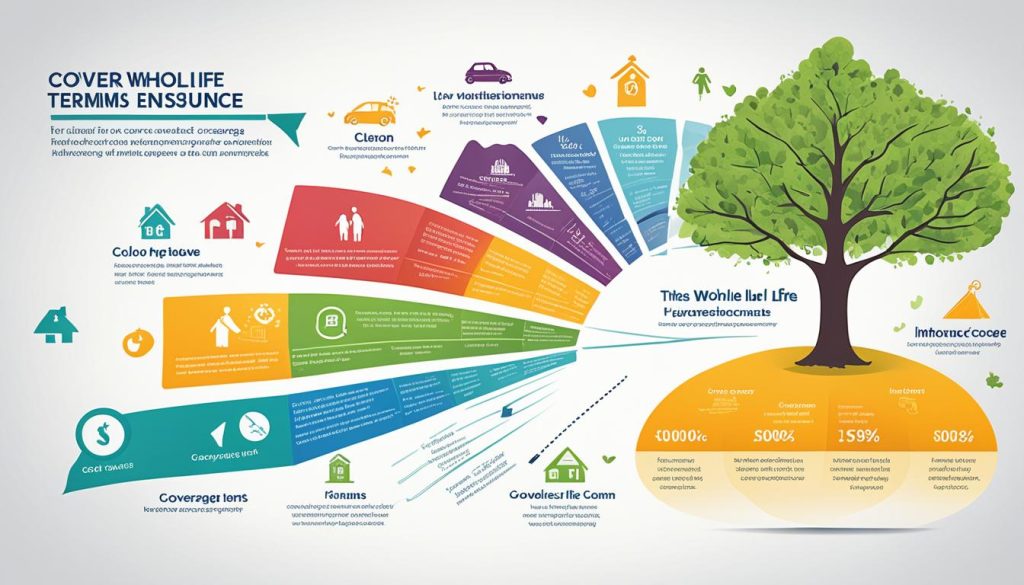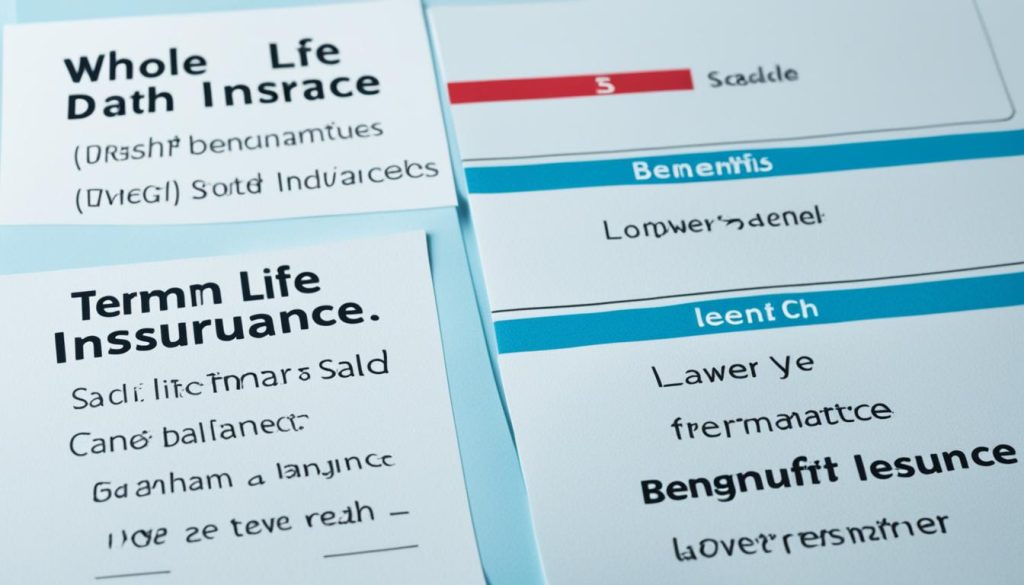In January 2023, 52% of Americans had some kind of life insurance1. This includes both individual policies and those from employers1. Picking the right life insurance is crucial for your retirement and your family’s future. Whole life insurance covers you for your entire life1. Term life insurance, on the other hand, lasts for a set time, like 10 to 30 years1.
Whole life insurance also grows a cash value over time1. Term life insurance does not have this cash value feature.
Key Takeaways
- Whole life insurance provides lifelong coverage, while term life insurance covers you for a set period.
- Whole life insurance has a cash value component that grows over time, while term life does not build any cash value.
- Whole life insurance is typically more expensive than term life insurance, with premiums that can be several times higher.
- Term life insurance can be significantly cheaper than whole life insurance, making it a more affordable option for many people.
- Choosing between whole life and term life insurance depends on your financial needs and goals, such as the need for permanent coverage, savings benefits, or temporary coverage for a specific period.
Whole Life vs. Term Life Insurance
Cost Comparison
Choosing between whole life and term life insurance depends a lot on the cost. Whole life insurance costs more because it covers you for life and has a cash value part2. Term life insurance is cheaper, especially for younger people2.
On average, a 20-year term life policy for a non-smoking man costs $2,352 a year for $500,000 coverage2. For a non-smoking woman, it’s $1,656 a year for the same coverage2. Whole life insurance costs more, at $3,593 a year, because it includes both insurance and investment parts2.
Buying insurance is cheaper if you’re young and healthy2. Women usually pay less for insurance because they live longer2.
| Coverage Type | Average Annual Premium for Non-Smoking Men | Average Annual Premium for Non-Smoking Women |
|---|---|---|
| Term Life ($500,000, 20-year) | $2,3522 | $1,6562 |
| Whole Life ($500,000) | $3,5932 | $3,1732 |
Term life insurance is cheaper but only covers you for a set time, usually 10 to 30 years3. Whole life insurance covers you for life if you keep paying premiums3. Whole life also grows in value over time, unlike term life which doesn’t3.
Choosing between whole life and term life depends on your budget, coverage needs, and financial goals. Think about the cost, how long you need coverage, and the cash value growth to make a choice that suits you234.
What is Term Life Insurance?
Term life insurance covers you for a set time, usually 10 to 30 years5. It pays out a death benefit to your loved ones if you die during this time5. Unlike whole life insurance, it doesn’t build cash value and is cheaper, especially for shorter terms5.
The cost depends on your age, health, and term length5. Premiums can be as low as $17 or as high as $54, making it a budget-friendly choice56.
Term life insurance is flexible. You can change the coverage amount and term to fit your budget and needs5. This flexibility lets you protect what’s important, like your home, family, or financial goals6.
Even without a cash value, term life insurance is crucial6. It can cover final costs, replace income, and ensure your family’s financial security if you pass away6.
Term life insurance is a simple and affordable way to get coverage6. Its flexible terms and cost-effectiveness make it a great choice for managing your finances and protecting your loved ones657.
What is Whole Life Insurance?
Whole life insurance covers you for your entire life if you keep paying premiums8. It’s different from term life insurance, which only covers you for a set time8. Whole life insurance gives you long-term protection and can grow in value over time8.
Cash Value Accumulation
Whole life insurance has a special feature called cash value. A part of your premiums builds this cash value, which grows over time9. You can use this cash value for emergencies, big purchases, or other financial goals8.
Whole life insurance also offers dividend payments if the company does well financially10. These dividends can increase the cash value of your policy10.
Whole life insurance costs more than term life insurance but covers you for life if you pay premiums10. You can borrow against the cash value, but this might lower the death benefit or policy value9.
In summary, whole life insurance gives you coverage for life and can grow in value over time8. It’s a good choice for those wanting long-term protection and to access funds when needed8. The main trade-off is higher premiums, but the guaranteed coverage and cash value growth make it appealing10.
Factors to Consider When Choosing
Coverage Needs and Affordability
Choosing between term and whole life insurance means looking at what you need and what you can afford. Term life is great if you need coverage for a certain time, like until your kids grow up or your mortgage is paid off11. Whole life, however, offers coverage for life and grows in value, which is good for long-term protection11.
Cost is a big factor to think about12. Term life is cheaper, with a 35-year-old paying about $30 a month for $500,000 coverage for 20 years12. Whole life costs more, with the same person paying around $571 a month12. This shows the extra benefits and life-long coverage you get with whole life.
Think about how long you need coverage13. Term life comes in 10, 20, or 30-year options, fitting your needs11. Whole life covers you for life if you keep paying premiums11.
| Feature | Term Life Insurance | Whole Life Insurance |
|---|---|---|
| Coverage Duration | 10, 20, or 30 years on average11 | Lifetime coverage11 |
| Premium Costs | More affordable, around $30/month for a 35-year-old12 | Higher premiums, around $571/month for a 35-year-old12 |
| Cash Value | No cash value component | Builds cash value over time12 |
Think about what you need and your finances to choose between term and whole life insurance. This way, you pick the best option for your goals and priorities111213.
Advantages and Disadvantages
Term and whole life insurance have their own benefits and drawbacks. Knowing these differences helps you pick the right policy for your needs and goals.
Term Life Insurance: Pros and Cons
Term life insurance is affordable. It costs less than other types14. This makes it great for those on a budget or needing coverage for a short time. Term policies last up to 30 years, fitting many protection needs14.
But, term insurance has a big drawback. It ends when the term is over. Unlike whole life, it doesn’t build cash value14. It’s not good for building wealth or tax planning14.
Whole Life Insurance: Pros and Cons
Whole life insurance protects you for life. It covers you from the start to the end14. Plus, it has a cash value that grows, letting you borrow or withdraw funds14. This cash value can be used tax-free, adding to its benefits14.
But, whole life insurance is pricier than term14115. It can be up to six times more expensive for the same coverage1. There are also surrender charges if you cancel early14, and the death benefit can be less if there are loans on the policy14.
Choosing between term and whole life insurance depends on your age, budget, and coverage needs15. Knowing the pros and cons of each helps you pick the best policy for your situation.
Alternatives to Consider
There are more policy options than just term and whole life insurance. Universal life, variable life, and indexed universal life might suit your needs better166.
Universal life insurance lets you change your premiums and death benefit as your life changes6. It also has a cash value part that grows tax-free6.
Variable life insurance is a type of permanent insurance that puts your cash value in funds like mutual funds. This could mean higher returns but also more risk6.
Indexed universal life insurance links your cash value growth to a market index, like the S&P 500. This could give you better returns than whole life, with a guaranteed death benefit6.
One-year term life insurance is great for short-term needs. It’s cheaper than longer-term policies, making it good for temporary coverage5.
When looking at these options, think about their features, costs, and risks. This will help you pick the best one for your needs and goals1665.
| Policy Type | Key Features | Potential Advantages | Potential Drawbacks |
|---|---|---|---|
| Universal Life Insurance | Flexible premiums and death benefits, cash value component | Customizable coverage, tax-deferred cash value growth | Potentially higher costs, risk of lapse if premiums not maintained |
| Variable Life Insurance | Cash value invested in sub-accounts, similar to mutual funds | Potential for higher returns, tax-deferred growth | Higher risk due to market exposure, fees and expenses may be higher |
| Indexed Universal Life Insurance | Cash value growth linked to a market index, such as the S&P 500 | Potential for better returns than traditional whole life, guaranteed death benefit | Complex structure, fees and expenses may be higher |
| One-Year Term Life Insurance | Temporary coverage, typically lower premiums | Affordable short-term protection, flexibility to adjust coverage as needed | No cash value accumulation, coverage only lasts for one year |
“When evaluating alternative life insurance policies, it’s crucial to understand the unique features, benefits, and drawbacks of each option to ensure you make an informed decision that aligns with your specific needs and financial goals.”
Looking into these options can help you find a policy that fits your budget and needs1665.
Conclusion
Choosing between term and whole life insurance depends on your needs, budget, and financial goals17. Term life insurance is cheaper and covers you for a certain time17. On the other hand, whole life insurance gives you coverage for life and grows in value over time.
When deciding, think about what you need, how much you can spend, and your future financial plans17. Talking to a financial advisor can also help pick the best life insurance for you.
Choosing term and whole life insurance is key to good financial planning. By looking at the good and bad of each, you can pick what fits your needs now and later. The right policy gives you peace of mind and security for your family.
FAQ
What percentage of Americans own life insurance?
What is the key difference between whole life and term life insurance?
How do the costs of whole life and term life insurance compare?
What is the purpose of term life insurance?
What is the purpose of whole life insurance?
What are the advantages and disadvantages of term life and whole life insurance?
What other life insurance options are available?
How do I choose between term life and whole life insurance?
Source Links
- Term vs. whole life insurance — here’s how to decide which is right for you
- Term vs. Whole Life Insurance: What’s the Difference?
- Term vs. Whole Life Insurance: Key Differences
- Term Life vs. Whole Life Insurance: Key Differences and How To Choose – NerdWallet
- Term vs. Whole Life Insurance: Which Is Right for Me?
- Aflac Supplemental Insurance
- Aflac Supplemental Insurance
- Term vs. Permanent Life Insurance
- Term vs. Whole Life Insurance: What’s The Difference?
- Term vs Whole Life Insurance | Bankrate
- Term Life Vs. Whole Life Insurance Which is Best for You
- Term vs. Whole Life Insurance: Differences & How to Choose
- Term vs. Whole Life Insurance: What’s the Difference?
- Term vs Whole Life Insurance: Key Differences Explained | HDFC Life
- Term vs. Whole Life Insurance: Pros and Cons | The Motley Fool
- Term vs. Whole Life Insurance: Differences & How to Choose
- Term Life Insurance vs. Whole Life Insurance: What’s the Difference? | Bank of Baroda



